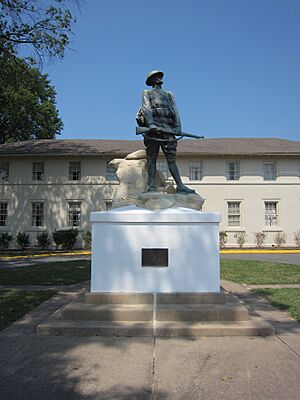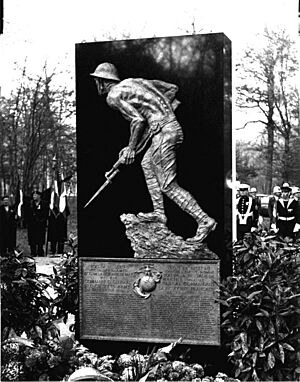Iron Mike facts for kids
Iron Mike is a popular nickname for many statues in the United States. These statues honor brave American soldiers, sailors, and Marines. The name "Iron Mike" is American slang for someone who is very tough, brave, and inspiring. It was first a term for a special compass on ships that kept them on a steady path. Because this nickname was popular in the early 1900s, many statues from that time got the "Iron Mike" name. Often, people forgot the original names given by the artists. Even official military books use the nickname more than the real titles.
Contents
Iron Mike in Quantico, Virginia
The "Iron Mike" statue in Quantico, Virginia, is officially called Crusading for Right. It shows a World War I Marine holding a Springfield rifle. He wears a pack with a bayonet.
After World War I, U.S. Army General John J. Pershing asked a French sculptor named Charles Raphaël Peyre to create a statue. It was meant to honor the Army's "doughboys." The sculptor did not know the differences between the Army and Marine Corps. So, he used a Marine private as his model. He even put the Eagle, Globe and Anchor symbol on the helmet.
When General Pershing saw the finished statue, he wanted the Marine symbol removed. The artist refused to change his work. Because of this, the Army did not buy the statue.
Later, Marine Corps General Smedley Butler raised money to buy it. He had the statue placed at Marine Corps Base Quantico. The statue was started in 1918. It was first shown in Paris in May 1919. Marine officers and enlisted members gave money to buy it. It was placed in front of the Base Headquarters in Quantico, Virginia. On November 10, 1921, three plaques were added. They honored Marines who died in World War I. The statue was officially dedicated on December 8, 1921.
Today, the original statue stands at Marine Corps Base Quantico. It is in front of Butler Hall. A copy of the statue, also called "Iron Mike," stands at the National Museum of the Marine Corps in Triangle, Virginia.
Iron Mike in Belleau, France
The "Iron Mike" at the Aisne-Marne American Cemetery and Memorial is in the Belleau Wood battlefield. It is a bronze sculpture on granite. Its simple title is The Marine Memorial. Felix Weihs de Weldon sculpted it. He also designed the large Marine Corps War Memorial in Washington, D.C. This monument was placed in the forest. It honors the 5th and 6th Marine Regiments. These units fought there for twenty days in June 1918.
This "Iron Mike" was dedicated on November 18, 1955. It is the only memorial in Europe just for the United States Marines. Below the statue is a plaque with a large Eagle, Globe, and Anchor. The plaque tells a short history of the battle in both English and French. The stone for the monument came from Karlshamn, Sweden. The statue and plaque together weigh about 4,082 kilograms (9,000 pounds).
The battle was very bloody for the U.S. Marine Corps at that time. The 5th and 6th Regiments received special French awards. After the war, the French government renamed the forest "Bois de la Brigade de Marine." This means "Wood of the Marine Brigade." General Lemuel C. Shepherd, Jr. led the dedication ceremony. He was the Commandant of the Marine Corps and had been wounded at Belleau Wood 37 years earlier. Three other Marine Generals who fought at Belleau Wood also attended.
Iron Mike in Parris Island, South Carolina
The "Iron Mike" at Parris Island shows a Marine carrying a Maxim machine gun. He holds an M1911 pistol in his raised left hand. This statue honors all Parris Island graduates who died in World War I.
The statue is about life-sized, standing about 2.4 meters (8 feet) tall. It is on a 1.5 meter (5 foot) granite base. Robert Ingersoll Aitken created it. He also sculpted parts of the United States Supreme Court Building. The statue is made of bronze. Its official name is Monument to U.S. Marines. It was dedicated in 1924 by Commandant John A. Lejeune. Due to new buildings, "Iron Mike" was moved in 1941. It now stands in front of the Parris Island Headquarters.
A bronze plaque on the base reads: "In memory of the men of Parris Island who gave their lives in the World War, erected by their comrades."
Iron Mike in Fort Bragg, North Carolina
Fort Bragg’s "Iron Mike" is called The Airborne Trooper. It is the newest "Iron Mike" statue. Fort Bragg is known as the "Home of the Airborne." It hosts the U.S. 82nd Airborne Division and the XVIII Airborne Corps. Leah Hiebert sculpted this statue in 1960 and 1961. She used Sergeant Major James Runyon as a model. The statue shows a World War II-era Airborne soldier ready with a Thompson submachine gun.
Lieutenant General Robert F. Sink wanted this statue created. It was not named for one person or unit. Instead, it honors all paratroopers, past, present, and future. Many famous generals attended its dedication. These included Omar Bradley and Matthew Ridgway. The Airborne Trooper was first placed at the southern entrance. In 1979, it moved to the traffic circle in front of the post headquarters. This was to protect it and make it more visible.
Fort Bragg’s first "Iron Mike" was 5 meters (16 feet 4 inches) tall. It weighed 1,467 kilograms (3,235 pounds). The original statue was made from polyester strips and epoxy over a steel frame. It started to wear out. So, in 2005, a bronze version replaced it. The original statue was fixed up. On June 14, 2010, it moved to the Airborne & Special Operations Museum in Fayetteville, North Carolina. A digital model of the original helped make the new bronze version look exactly the same. A ceremony for the new statue was held on September 23, 2005. President George W. Bush spoke in front of the statue on July 4, 2006.
La Fiere Replica
A copy of The Airborne Trooper stands near the bridge at La Fiere in Normandy, France. On June 6–9, 1944, soldiers from the 505th Parachute Infantry Regiment and 325th Glider Infantry Regiment fought a fierce battle there. These units were part of the 82nd Airborne Division. The small stone bridge over the Merderet River was very important. Germans wanted to take it to stop the American landing at Utah Beach. Americans needed it to expand their landing area in Normandy. The Germans attacked the Americans with infantry and tanks. But they could never cross the bridge. This monument was unveiled on June 7, 1997.
Iron Mike at University of Minnesota, Twin Cities
The University of Minnesota's Twin Cities campus also has a statue known as Iron Mike. Theo Alice Ruggles Kitson designed it. It was installed in 1906. The statue stands in front of the armory building. It is also called the "Student Soldier Memorial." This "Iron Mike" honors alumni who fought in the Spanish–American War. The statue is 2.7 meters (9 feet) tall. It stands on a 1.8 meter (6 foot) granite base. It shows a soldier in a uniform from that time. He wears a campaign hat and holds a Krag-Jørgensen rifle.
The real name of this sculpture is The Hiker. There are 39 copies of Kitson's Hiker still around. They are spread across the United States. The University of Minnesota's "Iron Mike" is one of the oldest Hikers in the U.S.
Other Iron Mike Statues
Many other similar statues exist across the United States. Most of them are World War I monuments. The most famous is a sculpture by Ernest Moore Viquesney. It is called Spirit of the American Doughboy. While this original statue design was not called "Iron Mike," people in some towns where copies are found call their local monuments by that name.
The U.S. Army Infantry Center at Fort Benning has a World War II monument. It is called Follow Me. People often mistakenly call it "Iron Mike."
Fort Lewis, Washington, has a statue called The Infantryman. It is also often called "Iron Mike." It was placed in 1964. It honors the soldiers of the 4th Infantry Division. The statue is 5.5 meters (18 feet) tall. It shows an early Vietnam-era U.S. infantryman with an M14 rifle. Its design was inspired by the "Iron Mike" at Fort Bragg. It is made from the same fiberglass-on-iron material.
In 1935, the Spirit of the CCC statue was created. It was later nicknamed Iron Mike. It was the first major statue honoring the Civilian Conservation Corps. John Palo-Kangas designed it. President Franklin D. Roosevelt unveiled it in Griffith Park, California. The original statue has since disappeared. But a bronze copy was made in 1993 by Jim Brothers.
Marine Corps Logistics Base Barstow has a training ridge nicknamed "Iron Mike." This is because it is very steep and hard to run up without stopping. Another running course at Marine Corps Base Camp Pendleton, Camp Horno, also shares this nickname.
Images for kids
See also
 In Spanish: Iron Mike para niños
In Spanish: Iron Mike para niños








